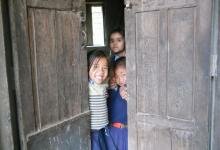Paani… chhaina? (No water?)
Politics stands as a formidable dyke between Nepal’s mighty rivers and its thirsty people.

Residents in Kathmandu jostle for access to water. Tankers such as this deliver water twice or thrice a week on an irregular schedule, and families need to fetch as much water as they can when it does arrive.
Photo credit: Edwin Koo
The monsoon has begun.
Almost every afternoon, rain would descend as butter-bean-sized drops, pelting hard on the unsuspecting pedestrian caught in its sudden outburst. Welcome: “bad” laundry days.
Still, the monsoon is an apt reminder that we live in the second most water-rich country in the world. Fed by the Himalayan glaciers, mighty rivers feed this country, as well as the entire Indian subcontinent, where a quarter of the world lives.
What may surprise most people then, is this: Kathmandu is a thirsty, parched city. The irony is not lost on its 1 million inhabitants, whose taps are dry 90% of the time, and water comes in tankers, twice or thrice a week, depending on where you live.
And when such a tanker appears (quite literally, because there is no fixed schedule), chaos ensues. Locals would troop back with containers of every assortment – used lubricant canisters, used paint buckets, and used Coke PET bottles. A riot of colours is only matched by the riot of protests. “Why are you not queueing up?” one would shout. “Hey, you’re taking forever! It's my turn!” another would yell.
They looked like a hundred hungry calves, fighting to suckle on a lone mother’s udders.
It had become an everyday scene in Kathmandu, melding into the social consciousness of the easy-going Nepalis. What appeared as a jarring problem that started years ago, had become a way of life, melding into the background. The residents have got used to it, save a few grouses.
But to a foreigner and a photographer, the reality cried out like an absurd scene from a bad comedy.
It’s hard to imagine that water was once a free resource in the Valley of Gods.
It’s hard to imagine that water was once a free resource in the Valley of Gods.
Before there was multi-party democracy, there was free water.
The monarchs, no matter how fatuous, made sure that public water taps were built. Hithis, or aqueduct outlets, flowed with so much water that it was painful to stand under one. The same hithis are dry now, thanks to mismanagement of water sources.
Of course, there is the much-vaunted Melamchi project, started in 1998 as an initiative to supply Kathmanduites adequate water with its targeted completion back in 2006/2007. Today, it is still incomplete.
The government project was doomed to fail, its fortunes tumbling along with the political state of Nepal. Presently, experts say it will not complete even by 2013. Ironically, even if it completes by 2012, it would not supply enough water to the burgeoning population of Kathmandu. Urban migration is simply outpacing urban planning and development, if there’s any to speak of in the first place.
And as if water shortage was not enough of a problem, over 47% of the piped water supplied to households is unfit for drinking. It is not uncommon to see brown, muddy water belch from public taps.
To make matters worse, upper-middle class households that can afford electric water pumps are piping ground water illegally, reducing the level of the ground water table, increasing the salinity of the soil. Bottled water suppliers are probably the only ones laughing their way to the bank, but even then, 17 of the 37 bottlers in the capital have failed basic tests by government agencies.
As the absurd black comedy plays on in Nepali everyday life, residents are taking showers in stagnant ponds, washing their laundry at murky rivers, and queueing up at public taps at 2am to get substandard potable water.
And we’re not talking about a forgotten backwater village. We’re talking about Kathmandu, Valley of Gods, capital of Nepal.
Edwin Koo also blogs at Naked Nepal.
Related Stories:
In Nepal, A New Kind of Rebellion



 Edwin Koo is a Singaporean photojournalist , who has been based in Nepal since September 2008. It is a labour of love to record down his experiences and fleeting thoughts , as he goes about photographing and documenting the fledgling Himalayan republic. You can also see pictures of everyday Nepal at his photoblog by the same name.
Edwin Koo is a Singaporean photojournalist , who has been based in Nepal since September 2008. It is a labour of love to record down his experiences and fleeting thoughts , as he goes about photographing and documenting the fledgling Himalayan republic. You can also see pictures of everyday Nepal at his photoblog by the same name.













